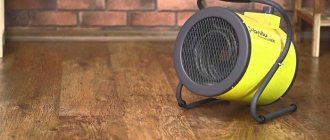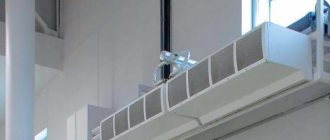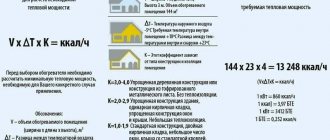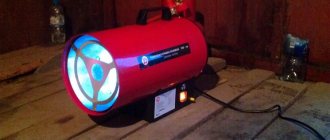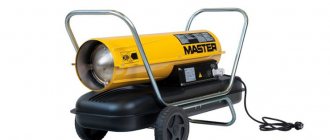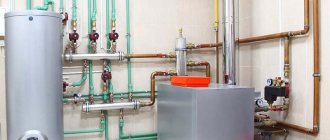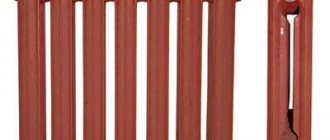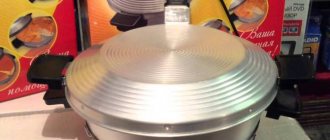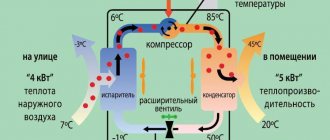What to consider when choosing
The main selection criterion is the thermal power of the device.
A correctly selected parameter will not only help to optimally heat the room, rationally using electrical energy, but will also help maintain the functionality of the gun for a long time.
Thermal electric guns can be calculated using the formula:
Р=VхТхК, kW
where V is the volume of the room; T – temperature difference between outside and inside the room; K – coefficient of thermal insulation of walls.
- K=3...4 – walls made of boards or steel corrugated sheets;
- K=2...2.9 – walls made of brick in one layer, roof without insulation, simple windows;
- K=1...1.9 – standard wall, roof and insulated windows;
- K=0.6...0.9 – walls made of two layers of brick, there is additional thermal insulation, high-quality plastic windows, additional thermal insulation of the roof.
The final result calculated using this formula is measured in kcal/hour.
To convert to watts, you need to multiply the resulting number by 1.16.
For rooms with an area of 5-6 m², 0.5 kW devices are suitable.
For every 2 additional m² we add 0.25 kW to 0.5.
In this way, the required power of the heat gun is determined.
The market for electric heat guns offers mobile and stationary options, so before purchasing, you should decide which one is more appropriate in your case.
If you intend to use the device constantly in the same room, for example, for a summer house, then you can purchase a stationary gun.
If you plan to use it as an additional heat source or the frequency of use is not too high, then it is wiser to take a mobile variety.
Pay attention to the design of the heating element. In rooms where people are often present, you should choose models with a closed thermoelement
In rooms where people are often present, you should choose models with a closed thermoelement.
Otherwise, human health may be negatively affected by the combustion products of debris particles that end up on the heating element.
A wide range of products allows you to choose the housing option that best fits into the environment.
You should also pay attention to the material from which it is made - choose the one that is most resistant to heat.
The noise level produced by the gun is of no small importance when installing it in rooms with people. To avoid discomfort, we recommend models with a noise level not exceeding 40 dB
To avoid discomfort, models with a noise level not exceeding 40 dB are recommended.
If the determining factor is the power of the device, for example installed on a construction site, then in this case the effectiveness will be much more important than the sound impact.
And, of course, an important factor is the cost of an electric heat gun.
It would be irrational to buy an expensive, powerful device for a ten-meter room.
And for large areas, such as construction sites, warehouses, and industrial premises, powerful industrial electric heat guns are needed, the cost of which can be 30-40 thousand rubles.
Taking into account the combination of all these factors, you can choose the most optimal option for an electric heat gun
Features of ceramic heat guns
Among the variety of heat gun models, a special place is occupied by devices equipped with ceramic heating elements, which slightly increases the cost of such devices, but has a positive effect on the performance characteristics, namely:
- the service life of the device increases without replacing the heating element;
- the quality characteristics of the heated air are improved (cleanliness, freshness, absence of foreign odors);
- the efficiency of using electrical energy increases.
Heat electric gun model “Ballu BKX-3” with a power of 2 kW, equipped with ceramic heating elements
Communications liner
It is necessary to take into account that the heating main must provide the required cross-section (the diameter must meet the technical requirements). And yet, the necessary flow of coolant through the fan heater must be ensured. If the diameter of the pipes and the temperature of the coolant are sufficient, but the speed of movement (flow) is very weak, this will negatively affect the thermal power of the device!
Also, think about how to supply power and control circuits. Calculate the required distances to purchase the required footage of electrical wire.
And one moment. Make sure that the wall (or ceiling) on which the fan heater will be mounted is of sufficient strength to withstand the load.
Characteristics of electric heat gun
This powerful device simultaneously performs several functions: it heats the room, ventilates the air and dries it. This is probably why the electric heat gun is so popular and in demand.
It is used not only on construction sites for heating and drying walls, but also in any garage when repairing a car, in the basement, in warehouses, in shops and country houses. Rectangular guns attach well to the wall, while cylindrical guns are ideal for spot heating.
The principle of its operation is quite simple: with the help of a powerful fan, air is driven through the heating element and distributed throughout the room. The air in the room heats up very quickly, so this type of air heater is most often used in winter.
Diagram of a gas heat gun.
Using an electric heat gun is convenient because you do not need to coordinate its installation with numerous regulatory authorities. These devices are reliable and durable.
Those devices that operate on a voltage of 380 V have a power of up to 25 kW. The temperature is adjusted using step-by-step starting, and there are all the necessary overheating protection functions. The weight of these devices reaches 30 kg. High-quality devices from well-known manufacturers are equipped with heating elements that do not burn oxygen.
Operating principle of an electric air gun-heater
Operating principle of an electric heat gun
The operating principle of the electric air gun is shown in the following figure and is carried out as follows:
- an axial fan (No. 2 in the figure) sucks in cold air (No. 3) and directs it to heating elements (No. 7), which can be various types of heating elements or a spiral;
- When voltage is applied to the heating elements, they heat up and transfer their heat to the air flowing around them, as a result of which the air at the outlet of the device (No. 5) is much warmer than at the inlet;
- to protect the heating elements and safe operation of the device, protective grilles are installed at the entry and exit points (No. 6);
- the electrical control circuit, as well as devices designed to regulate operating modes, are mounted in the control unit (No. 8);
- to carry the gun there is a handle on its body (No. 1), and for stability during use there are special legs (No. 4).
The heating elements used in such devices have a complex, spiral shape, which allows increasing the area of contact of the heating element with the air flows passing through it. Operating modes are set using controls, and the stability of the device is achieved by installing legs - for low-power models or wheels - for more powerful modifications. Connection to the electrical network is made using a cable equipped with a standard plug.
Electric heat gun model “Ecoterm EHR-03/1A”
Tips for choosing an electric heat gun
When buying any device, everyone wants it to work not only efficiently, but also for as long as possible. Therefore, we choose electric heat guns only from well-known manufacturers.
The body of the device must be made of metal; if a scattering grille is installed, it must also be metal. This is guaranteed to protect the device from deformation due to temperature changes and in the event of a power outage, when the fan stops and the heating elements do not have time to cool down, nothing will happen to the heat gun.
An electric heat gun must have a stable, durable design.
You need to choose a device whose body is marked: 24/2 or 24/1. This means that this heat gun can work around the clock, with a break in operation of 1 or 2 hours.
Pay attention to the presence of overheating protection, a heating level regulator, and an air flow switch (switching fan speed). A huge advantage is the presence of a service center in your area
A huge advantage is the presence of a service center in your area.
Electric gun device for heating rooms
The design of an electric heat gun, operating from a household electrical network with a voltage of 220 Volts, is quite simple and consists of a housing in which other structural elements are located:
- Heating elements that serve as heating elements of the device;
- a fan that provides the required air circulation.
Important! To protect against accidents and ensure fire safety, protective grilles are mounted on the outside of the housing, and for ease of use, there is a handle that allows you to carry the heating device.
Basic design elements of a heat electric gun for household use
To provide different operating modes, the devices are equipped with regulators that allow you to turn on the required number of heating elements, which allows you to control the temperature of the heated air, as well as the fan rotation speed, thereby regulating the air exchange rate in the heated room.
Types of heating elements
Diagram of operation of a diesel heat gun.
An electric heat gun can have two types of heating elements located in it: a heating element in the form of a spiral or a heating element.
When using heating elements, the device heats up more slowly and the heating temperature is not as high as when using a spiral. But such a heat gun is much safer and more durable than a spiral one. This happens because dust and debris do not collect on the heating elements, so accidental fires are minimized. It is the choice of a heat gun using heating elements that is recommended for use in residential premises.
An electric heat gun using a spiral heating element is characterized by almost instantaneous heating, the atmosphere in the room quickly becomes comfortable for further work, but at the same time some of the oxygen is burned. Therefore, it is not recommended to use it in residential enclosed spaces; it is better to use such a device in a garage, outbuildings, etc.
These air heaters can operate at voltages of 220 V and 380 V.
